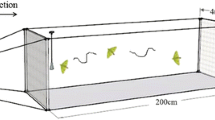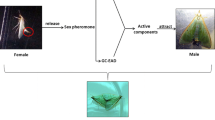Abstract
Helicoverpa armigera (Lepidoptera: Noctuidae) is a widespread kind of pest in Iran and many countries around the world which are economically important. )Z(-11-hexadecenal has been identified as a major component of the female sex pheromone of H. armigra moths. In the present study, gas chromatography-mass spectrometry (GC–MS) was used for the identification and determination of (Z)-11-hexadecenal. (Z)-11-hexadecenal is a long-chain aliphatic aldehyde. It was also measured by bacterial bioluminescence assay based on Luciferase-FMNH2 complex, NADH, aldehyde and O2 as a sensitive and selective method. The detection limit of )Z(-11-hexadecenal was obtained 0.019 mg/L in the linear range of 0.05–4.5 mg/L by the bioluminescence assay and the GC–MS analysis amount was 1.5 mg/L with the linearity range of 5–50 mg/L. The relative standards deviation for three measurements was 1.92 and 5.7% by bioluminescence assay and GC–MS, respectively. The average amount of (Z)-11-hexadecenal in sex pheromone per moth in 2–3 days old virgin female with the bioluminescence assay and GC–MS were obtained 3.2 and 3.02 ng ml−1, respectively. Afterward, the amount of (Z(-11-hexadecenal was compared with 8–10 days old adult females by bacterial bioluminescence assay.
Graphical abstract






Similar content being viewed by others
References
Y. Fathipour, B. Naseri, In: Soybean cultivars affecting performance of Helicoverpa armigera (Lepidoptera: Noctuidae): INTECH Open Access Publisher: Tehran. (2011)
B. Naseri, Y. Fathipour, S. Moharramipour, V. Hosseininaveh, Entomol. Sci. 12, 147–154 (2009)
G.P. Fitt, Annu. Rev. Entomol. 34, 17–53 (1989)
I. Common, Aust. J. Zool. 1, 319–344 (1953)
C.P. Topper, Bull. Entomol. Res. 77, 525–539 (1987)
M. Sarwar, Int. J. Eng. Adv. Res. Technol. 1, 27–31 (2015)
N.J. Armes, D.R. Jadhav, K.R. DeSouza, Bull. Entomol. Res. 86, 499–514 (1996)
G. Terefe, S. Jamornmarn, Pest Manag. J. Ethiopia (Ethiopia) 1, 1–7 (2005)
T. Nazir, S. Khan, D. Qiu, Biological control of insect pest, In: Pests Control and Acarology, IntechOpen (2019)
W.D. Kirk, Int. J. Trop. Insect Sci. 37, 41–49 (2017)
P. Witzgall, P. Kirsch, A. Cork, J. Chem. Ecol. 36, 80–100 (2010)
S. Tewari, T.C. Leskey, A.L. Nielsen, J.C. Piñero, C.R. Rodriguez-Saona, Use of pheromones in insect pest management, with special attention to weevil pheromones, in Integrated pest management. (Elsevier, Amsterdam, 2014), pp.141–168
J.-P. Zhang, C. Salcedo, Y.-L. Fang, R.-J. Zhang, Z.-N. Zhang, J. Insect Physiol. 58, 1209–1216 (2012)
D. Wu, Y. Yan, J. Cui, Insect Sci. 4, 350–356 (1997)
R.A. Jurenka, Insect Pheromone Biochem. Mol. Biol. (Second Edition) 13, 88 (2021)
P. Piccardi, A. Capizzi, G. Cassani, P. Spinelli, E. Arsura, P. Massardo, J. Insect Physiol. 23, 1443–1445 (1977)
B. Nesbitt, P. Beevor, D. Hall, R. Lester, J. Insect Physiol. 25, 535–541 (1979)
B. Nesbitt, P. Beevor, D. Hall, R. Lester, Entomol. Exp. Appl. 27, 306–308 (1980)
M. Kehat, E. Dunkelblum, J. Insect Behav. 3, 75–83 (1990)
E. Meighen, K. Slessor, G. Grant, Experientia 37, 555–557 (1981)
N.A. Tyulkova, S.E. Medvedeva, E.K. Rodicheva, A.M. Kuznetsov, Bioluminescence in focus—a collection of illuminating essays. Res. Signpost Trivandrum, India 1, 27–49 (2009)
A. Fleiss, K.S. Sarkisyan, Curr. Genet. 65, 877–882 (2019)
E. Meighen, K. Slessor, G. Grant, J. Chem. Ecol. 8, 911–921 (1982)
E. Meighen, K. Slessor, G. Grant. J. Knox (ed.) Bioluminescence and chemiluminescence: basic chemistry and analytical applications. Academic Press, New York. 1, 409–416 (1981)
M.E. Smith, L.B. Smith, Biol. Bull. 96, 233–237 (1949)
A. Tyler, N.H. Horowitz, Science 86, 85–86 (1937)
M. Kakizaki, H. Sugie, Appl. Entomol. Zool. 38, 73–78 (2003)
S. Wakamura, A. Tanaka, K. Yasuda, T. Yasuda, Appl. Entomol. Zool. 36, 71–76 (2001)
S. Nojima, A. Classen, A.T. Groot, C. Schal, PLoS ONE 13, 1–13 (2018)
C.D. Pearson, S.G. Gharfeh, J. Chromatogr. 329, 142–146 (1985)
S.N. Brune, J.R. Phillips, D.R. Bobbitt, Microchem. J. 44, 288–295 (1991)
A. Forootan, R. Sjöback, J. Björkman, B. Sjögreen, L. Linz, M. Kubista, Biomol. Detect. Quantif. 12, 1–6 (2017)
A. Virgilio, A.B.S. Silva, A.R.A. Nogueira, J.A. Nóbrega, G.L. Donati, J. Anal. At. Spectrom. 35, 1614–1620 (2020)
A. Asfaw, M.W. Blair, Agric. Sci. 2014, 1–10 (2014)
Acknowledgements
The authors would like to thank the Tirtash Research and Training Center, Behshahr, Iran, and Mr. Afshin Sajjadi for their cooperation in preparing sample.
Author information
Authors and Affiliations
Corresponding author
Rights and permissions
Springer Nature or its licensor (e.g. a society or other partner) holds exclusive rights to this article under a publishing agreement with the author(s) or other rightsholder(s); author self-archiving of the accepted manuscript version of this article is solely governed by the terms of such publishing agreement and applicable law.
About this article
Cite this article
Chaichi, M.J., Mohammadkhani, S., Mohseni, M. et al. Identification and determination of (Z)-11-hexadecenal in sex pheromone of Helicoverpa armigera by GC–MS and bacterial bioluminescence methods. J IRAN CHEM SOC 20, 477–483 (2023). https://doi.org/10.1007/s13738-022-02682-w
Received:
Accepted:
Published:
Issue Date:
DOI: https://doi.org/10.1007/s13738-022-02682-w




